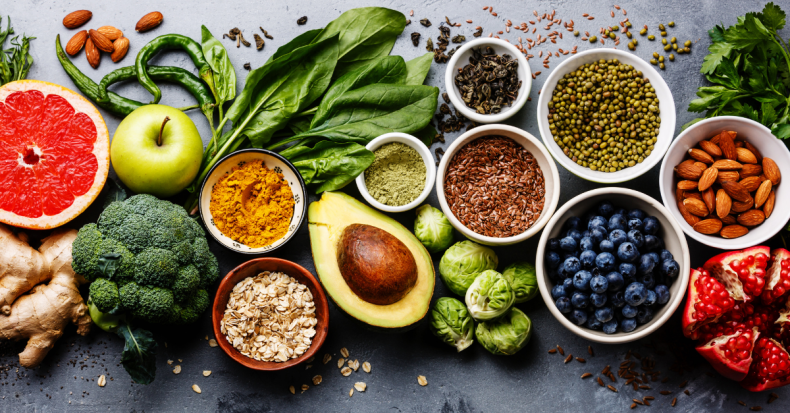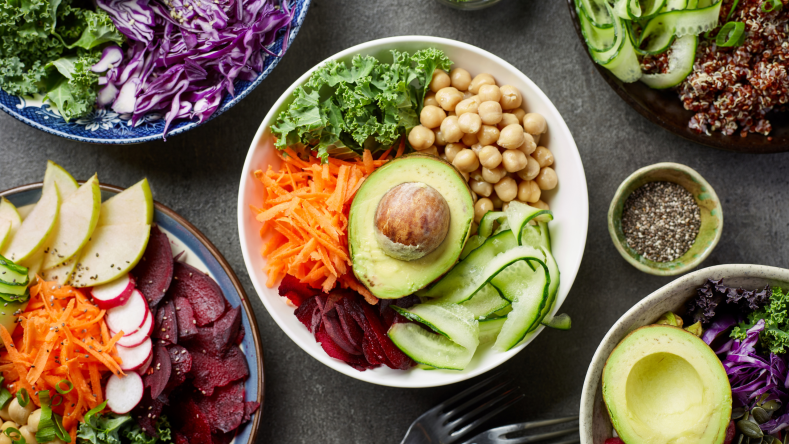6 ways to tell you’re not getting enough fruits and vegetables
It’s a well-known fact that fruits and vegetables greatly benefit health, but what happens when you don’t eat enough of them? Here’s what science has to say about how your produce intake impacts your mood, digestion, skin health, and more.

Research has long shown that adequate fruit and vegetable consumption is correlated with a reduced risk of many chronic diseases–including cardiovascular disease, type 2 diabetes, some cancers, and obesity. Yet, despite the benefits, only 10% of Americans consume the recommended 5 servings of fruits and vegetables per day [ 6
What’s the difference between fruits and vegetables?
It’s a well-known fact that fruits and vegetables are good for you, but do you know what classifies one from the other? From taste to nutrition, here’s the difference between fruits and vegetables.
Fruits: By definition, fruit is the sweet and fleshy product of a tree or other plant that contains seeds [
1
]. Fruits have a sweet or tart flavor, and are most often enjoyed in juices, smoothies, snacks, desserts, and more. Some common fruits include berries, apples, bananas, grapes, pears, and oranges, as well as other mistaken vegetable options like tomatoes, cucumbers, eggplant, olives, zucchini, and avocados [2
].Vegetables: A plant is considered to be a vegetable if it consists of all edible plant matter, like the roots, stems, and leaves [
3
]. Vegetables tend to have a more mild or savory taste, and can be eaten alone or as part of a meal. Some common vegetables include cabbage, artichokes, mushrooms, onions, carrots, spinach, cauliflower, celery, and radishes [4
].

How many fruits and vegetables a day?
According to the 2020-2025 Dietary Guidelines for Americans, it’s recommended to consume at least 5 servings of fruits and vegetables each day to help reduce the risk of chronic disease and enhance overall health [ 5
However, recent findings show that only 1 in 10 adults meets the recommended guidelines for fruit or vegetable consumption, with this number dropping even lower among those in poverty stricken communities or food deserts [ 6
How to tell if you need more produce
Not getting enough fruits and vegetables can take a toll on your body over time. Here are six warning signs that you need to include more produce in your diet.
Mood swings.
Studies suggest that the amount of produce you put on your plate may be correlated to your overall mood.
Research has shown that B vitamins (found in leafy greens and citrus fruits), zinc (found in mushrooms, berries, and kale) and carotenoids (found in sweet potatoes, carrots, and dark leafy greens) may promote happier moods, have a positive influence on mental health, and improve optimism levels [ 7 8 9 10
Adequate fruit and vegetable consumption has also been associated with a reduced risk of blood sugar crashes, which can, in turn, result in stable moods throughout the day. For instance, berries have been shown to enhance insulin sensitivity and promote better blood sugar management, whereas quercetin and sulforaphane (compounds found in kale and broccoli, respectively) may help lower blood sugar and markers of oxidative stress [ 11 12 13
You’re not “regular”.
If your digestive system is out of whack, you may want to examine how many fruits and veggies you’re consuming.
Fruits and vegetables are high in fiber, a nutrient that enhances satiety, slows stomach emptying, increases digestion time, and helps keep you regular [ 14 15
It’s recommended to consume 25-30 g of fiber/day for optimal digestive health. To put this in perspective, one serving of vegetables contains around 4 g of fiber, so if you were to consume 5 servings per day, you would be close to meeting the recommended daily amount.
Your skin looks dull.
Fruits and vegetables contain vitamins that help your skin glow, such as vitamins C and E, so if you notice that your skin is looking a bit lackluster, you may want to step up your produce intake.
Vitamin C is an antioxidant that plays an important role in the synthesis and maintenance of collagen, which is a protein that has been shown to improve skin texture and reduce the appearance of fine lines and wrinkles [ 16 17
Vitamin E is another important anti-inflammatory vitamin that may be beneficial in reducing UV damage to the skin [ 18

High stress levels.
Research indicates that consuming 5 servings of fruits and vegetables each day can reduce inflammation and lower stress levels, thanks to the high amount of antioxidants present in these foods [ 19 20 29 21
Weakened immune system.
Western-type diets tend to contain high amounts of saturated fat, ultra-processed foods, added sugars, and salt, which can all impact health and chronic disease risk [ 22 insufficient intake of certain nutrients vitamin D 23 24

You have a hard time losing weight.
If you want to lose weight but the scale isn’t budging, your produce intake might be to blame.
Fruits and vegetables are naturally rich in fiber, which is a nutrient that enhances satiety, slows digestion, and keeps you fuller for longer. As such, it can aid in weight control, as studies show that adults who ate several servings of fiber-rich whole grains each day had a smaller change in waist size when compared to those who rarely ate whole grains [ 25 26

Ways to eat more fruits and vegetables
Now that you know the health benefits of consuming adequate fruits and vegetables, you may be looking for easy, attainable ways to include more fruits and vegetables into your diet. Here are some science-backed suggestions to help you out.
Don’t discriminate. Fresh and frozen produce items both offer incredible health benefits, and can be beneficial for different reasons. Fresh fruits and vegetables are best when they are in season, whereas frozen options are available year round and can be more affordable. However, both options provide a plethora of vitamins and minerals, as studies have found that the antioxidant activity and levels of vitamin A, carotenoids, vitamin E, minerals and fiber are similar in both fresh and frozen produce [
27
,28
]. Ultimately, the option that’s best for you will depend on taste preferences, accessibility, seasonality, and budgetary needs.Enhance your existing foods. One of the easiest ways to get more fruits and vegetables into your diet is to add them to what you’re already eating. A few ways to do this would be to throw some spinach into your morning smoothie, top your yogurt with fresh or frozen berries, or add extra vegetables into sauces, eggs, casseroles, and tacos.
Prepare in advance. Grab and go options are a convenient way to up your fruit and veggie intake, so the next time you come back from the store, spend a few minutes washing, cutting, and storing your produce. By having your fruits and vegetables prepped and ready to go, it can help you eat more of them simply due to the convenience and portability factor.
Have visual reminders. The saying “out of sight, out of mind” applies to many things, but it’s especially true when it comes to produce. If you keep your fruits and vegetables buried at the bottom of your fridge, it can be easy to forget about them. Instead, place them in high traffic areas around your kitchen as a visual reminder to include more in your daily diet.
Summary
Eating the recommended amount of fruits and vegetables is correlated with a reduced risk of many chronic diseases–including cardiovascular disease, type 2 diabetes, some cancers, and obesity. Yet, despite the numerous benefits, only 10% of Americans consume the recommended 5 servings per day. Not consuming enough produce can wreak havoc on your mood, skin, digestive system, immune health, weight, and stress levels. You can boost your intake by choosing frozen produce, preparing options in advance, adding them to existing foods, and setting visual reminders around your kitchen.
Disclaimer: The text, images, videos, and other media on this page are provided for informational purposes only and are not intended to treat, diagnose or replace personalized medical care.
Key takeaways
According to the 2020-2025 Dietary Guidelines for Americans, it’s recommended to consume at least 5 servings of fruits and vegetables each day to help reduce the risk of chronic disease and enhance overall health [
5
].Recent findings show that only 1 in 10 adults meet the recommended guidelines for fruit or vegetable consumption, with this number dropping even lower among those in poverty stricken communities and food deserts [
6
].Emerging evidence suggests that people who ate at least 5 servings of fruit and vegetables daily experienced a 10% reduction in stress levels compared to those who consumed less than 3 servings/day [
21
].A lack of fruit and vegetable intake may be representative of an overall eating pattern that is low in key nutrients essential to immune function, such as vitamin D, zinc, and vitamin C [
23
].You can boost your fruit and veggie intake by choosing frozen produce, preparing options in advance, adding them to foods and meals you are already eating, and setting visual reminders around your kitchen.
References:
Encyclopædia Britannica, inc. (n.d.). Fruit. Encyclopædia Britannica. Retrieved June 2, 2022, from
https://www.britannica.com/science/fruit-plant-reproductive-body
Abadi, M. (2018, June 24). 14 vegetables that are actually fruits. Business Insider. Retrieved June 2, 2022, from
https://www.businessinsider.com/fruits-and-vegetables-difference-2018-6?IR=T
Encyclopædia Britannica, inc. (n.d.). Vegetable. Encyclopædia Britannica. Retrieved June 2, 2022, from
https://www.britannica.com/topic/vegetable
Vegetables. MyPlate. (n.d.). Retrieved June 2, 2022, from
https://www.myplate.gov/eat-healthy/vegetables
Current dietary guidelines. Dietary Guidelines for Americans, 2020-2025 and Online Materials | Dietary Guidelines for Americans. (n.d.). Retrieved June 2, 2022, from
https://www.dietaryguidelines.gov/resources/2020-2025-dietary-guidelines-online-materials
Centers for Disease Control and Prevention. (2018, February 26). Disparities in state-specific adult fruit and vegetable consumption - United States, 2015. Centers for Disease Control and Prevention. Retrieved June 2, 2022, from
https://www.cdc.gov/mmwr/volumes/66/wr/mm6645a1.htm?s_cid=mm6645a1_w
Głąbska, D., Guzek, D., Groele, B., & Gutkowska, K. (2020). Fruit and Vegetable Intake and Mental Health in Adults: A Systematic Review. Nutrients, 12(1), 115.
https://doi.org/10.3390/nu12010115
Young, L. M., Pipingas, A., White, D. J., Gauci, S., & Scholey, A. (2019). A Systematic Review and Meta-Analysis of B Vitamin Supplementation on Depressive Symptoms, Anxiety, and Stress: Effects on Healthy and 'At-Risk' Individuals. Nutrients, 11(9), 2232.
https://doi.org/10.3390/nu11092232
Cope, E. C., & Levenson, C. W. (2010). Role of zinc in the development and treatment of mood disorders. Current opinion in clinical nutrition and metabolic care, 13(6), 685–689.
https://doi.org/10.1097/MCO.0b013e32833df61a
Boehm, J. K., Williams, D. R., Rimm, E. B., Ryff, C., & Kubzansky, L. D. (2013). Association between optimism and serum antioxidants in the midlife in the United States study. Psychosomatic medicine, 75(1), 2–10.
https://doi.org/10.1097/PSY.0b013e31827c08a9
Stull A. J. (2016). Blueberries' Impact on Insulin Resistance and Glucose Intolerance. Antioxidants (Basel, Switzerland), 5(4), 44.
https://doi.org/10.3390/antiox5040044
Al-Ishaq, R. K., Abotaleb, M., Kubatka, P., Kajo, K., & Büsselberg, D. (2019). Flavonoids and Their Anti-Diabetic Effects: Cellular Mechanisms and Effects to Improve Blood Sugar Levels. Biomolecules, 9(9), 430.
https://doi.org/10.3390/biom9090430
Teng, W., Li, Y., Du, M., Lei, X., Xie, S., & Ren, F. (2019). Sulforaphane Prevents Hepatic Insulin Resistance by Blocking Serine Palmitoyltransferase 3-Mediated Ceramide Biosynthesis. Nutrients, 11(5), 1185.
https://doi.org/10.3390/nu11051185
Hervik, A. K., & Svihus, B. (2019). The Role of Fiber in Energy Balance. Journal of nutrition and metabolism, 2019, 4983657.
https://doi.org/10.1155/2019/4983657
Low fiber diet. Low Fiber Diet - an overview | ScienceDirect Topics. (n.d.). Retrieved June 2, 2022, from
https://www.sciencedirect.com/topics/nursing-and-health-professions/low-fiber-diet
Choi, F. D., Sung, C. T., Juhasz, M. L., & Mesinkovsk, N. A. (2019). Oral Collagen Supplementation: A Systematic Review of Dermatological Applications. Journal of drugs in dermatology : JDD, 18(1), 9–16.
Pullar, J. M., Carr, A. C., & Vissers, M. (2017). The Roles of Vitamin C in Skin Health. Nutrients, 9(8), 866.
https://doi.org/10.3390/nu9080866
Keen, M. A., & Hassan, I. (2016). Vitamin E in dermatology. Indian dermatology online journal, 7(4), 311–315.
https://doi.org/10.4103/2229-5178.185494
Hosseini, B., Berthon, B. S., Saedisomeolia, A., Starkey, M. R., Collison, A., Wark, P., & Wood, L. G. (2018). Effects of fruit and vegetable consumption on inflammatory biomarkers and immune cell populations: a systematic literature review and meta-analysis. The American journal of clinical nutrition, 108(1), 136–155.
https://doi.org/10.1093/ajcn/nqy082
Liu, Y. Z., Wang, Y. X., & Jiang, C. L. (2017). Inflammation: The Common Pathway of Stress-Related Diseases. Frontiers in human neuroscience, 11, 316.
https://doi.org/10.3389/fnhum.2017.00316
Edith Cowan University. (2021, May 14). Eating more fruit and vegetables linked to less stress, study finds. ScienceDaily. Retrieved June 2, 2022 from
www.sciencedaily.com/releases/2021/05/210513100030.htm
Christ, A., Lauterbach, M., & Latz, E. (2019). Western diet and the immune system: An inflammatory connection. Immunity, 51(5), 794–811.
https://doi.org/10.1016/j.immuni.2019.09.020
Childs, C. E., Calder, P. C., & Miles, E. A. (2019). Diet and Immune Function. Nutrients, 11(8), 1933.
https://doi.org/10.3390/nu11081933
de Frel, D. L., Atsma, D. E., Pijl, H., Seidell, J. C., Leenen, P. J., Dik, W. A., & van Rossum, E. F. (2020). The impact of obesity and lifestyle on the immune system and susceptibility to infections such as COVID-19. Frontiers in Nutrition, 7.
https://doi.org/10.3389/fnut.2020.597600
Tufts University, Health Sciences Campus. (2021, July 13). Eating whole grains linked to smaller increases in waist size, blood pressure, blood sugar: Study in middle- to older-aged adults suggests whole grains may protect against heart disease. ScienceDaily. Retrieved June 2, 2022 from
www.sciencedaily.com/releases/2021/07/210713165308.htm
Miketinas, D. C., Bray, G. A., Beyl, R. A., Ryan, D. H., Sacks, F. M., & Champagne, C. M. (2019). Fiber intake predicts weight loss and dietary adherence in adults consuming calorie-restricted diets: The pounds lost (preventing overweight using novel dietary strategies) study. The Journal of Nutrition, 149(10), 1742–1748.
https://doi.org/10.1093/jn/nxz117
Bouzari, A., Holstege, D., & Barrett, D. M. (2015). Mineral, fiber, and total phenolic retention in eight fruits and vegetables: a comparison of refrigerated and frozen storage. Journal of agricultural and food chemistry, 63(3), 951–956.
https://doi.org/10.1021/jf504890k
Rickman, J. C., Bruhn, C. M., & Barrett, D. M. (2007). Nutritional comparison of fresh, frozen, and canned fruits and vegetables II. vitamin A and carotenoids, vitamin E, minerals and Fiber. Journal of the Science of Food and Agriculture, 87(7), 1185–1196.
https://doi.org/10.1002/jsfa.2824
Lobo, V., Patil, A., Phatak, A., & Chandra, N. (2010). Free radicals, antioxidants and functional foods: Impact on human health. Pharmacognosy reviews, 4(8), 118–126.
https://doi.org/10.4103/0973-7847.70902







